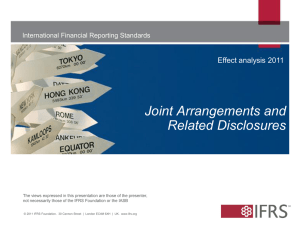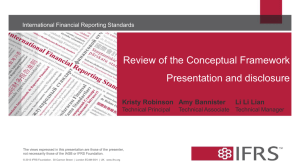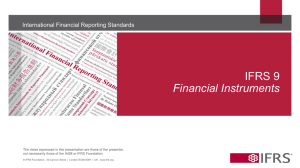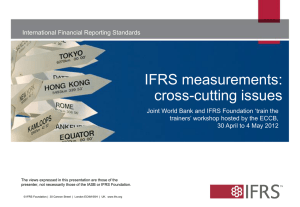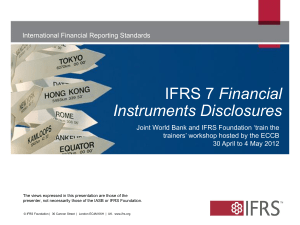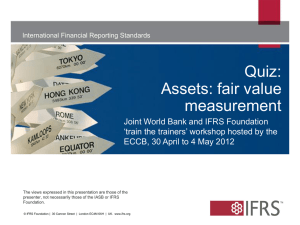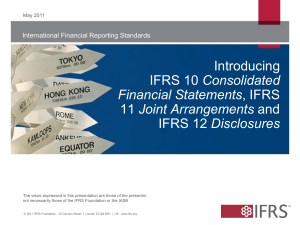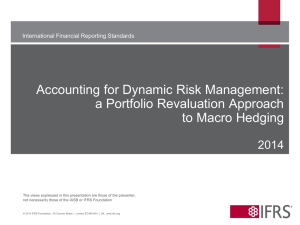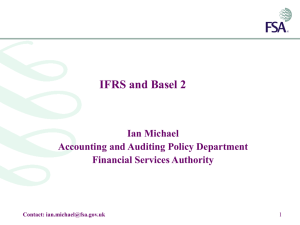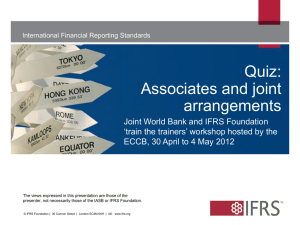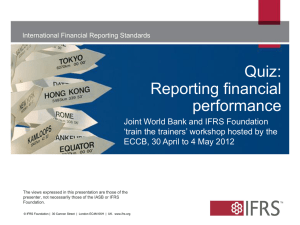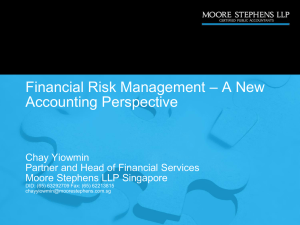Slides
advertisement
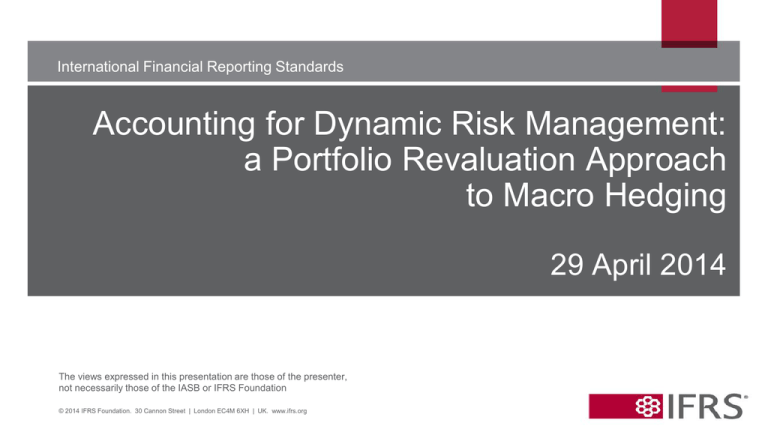
International Financial Reporting Standards Accounting for Dynamic Risk Management: a Portfolio Revaluation Approach to Macro Hedging 29 April 2014 The views expressed in this presentation are those of the presenter, not necessarily those of the IASB or IFRS Foundation © 2014 IFRS Foundation. 30 Cannon Street | London EC4M 6XH | UK. www.ifrs.org Housekeeping items 2 • Slides can be downloaded by clicking on the button below the slides window. • To ask a question, type into the designated text box on your screen and click to submit. • Remember to turn off your pop-up blocker. • A recording of the webcast will be available online at www.ifrs.org. © IFRS Foundation. 30 Cannon Street | London EC4M 6XH | UK. www.ifrs.org At a glance 3 • The IASB is exploring an accounting approach to better reflect dynamic risk management (DRM) activities in entities’ financial statements. • The Discussion Paper (DP) uses dynamic interest rate risk management by banks for illustrative purposes. However, the approach considered in the DP is intended to be applicable to other risks (for example, commodity price risk and FX risk). © IFRS Foundation. 30 Cannon Street | London EC4M 6XH | UK. www.ifrs.org Dynamic Risk Management (DRM) 4 • DRM is a continuous process. • Major characteristics of DRM include: dynamic DRM is undertaken for open portfolio(s), to which new exposures are frequently added and in which existing exposures mature. As the risk profile of the open portfolio(s) changes, DRM is updated frequently in reaction to the changed net risk position. © IFRS Foundation. 30 Cannon Street | London EC4M 6XH | UK. www.ifrs.org Challenges under IAS39/IFRS9 hedge accounting 5 • Current hedge accounting requirements are often difficult to apply to DRM because: One-to-one linkage between what is being hedged and the hedging derivative; Can only indirectly accommodate DRM on a net basis through gross designation; Can only accommodate open portfolios by treating them as a series of closed portfolios with short lives; Allows for a degree of behaviouralisation of exposures but this is limited. © IFRS Foundation. 30 Cannon Street | London EC4M 6XH | UK. www.ifrs.org Dynamic interest rate risk management in banks 6 The purpose of dynamic RM is usually to manage Net Interest Income The Portfolio Revaluation Approach (PRA) 7 • Exposures within open portfolios are revalued with respect to the managed risk (for example, interest rate risk). • Not a full fair value model. © IFRS Foundation. 30 Cannon Street | London EC4M 6XH | UK. www.ifrs.org The PRA (continued) • The net effect between the revaluation adjustment of the managed exposures and the fair value changes of the risk management instruments (for example, interest rate swaps) is reflected in profit or loss. © IFRS Foundation. 30 Cannon Street | London EC4M 6XH | UK. www.ifrs.org 8 Expected improvements with the PRA 9 enhances information about DRM; reduces operational complexities such as tracking and amortisations; captures the dynamic nature of risk management on a net basis; considers behavioural factors; considers different types of risks managed in open portfolios. © IFRS Foundation. 30 Cannon Street | London EC4M 6XH | UK. www.ifrs.org Behaviouralisation (‘core’ demand deposits) 10 amount outstanding Core demand deposits time • At a portfolio level, the ‘sticky’ nature of demand deposits leads to the identification of a stable portion in the amount outstanding. • These core demand deposits are deemed to be fixed rate deposits with longer maturities for risk management purposes (behaviouralisation). Scope of the application of the PRA 11 • The scope has significant implications for the information provided to users of financial statements and on how operationally feasible the application of the PRA will be for an entity. • The DP considers two scope alternatives: – Focus on dynamic risk management – Focus on risk mitigation (sub-portfolio approach, proportional approach) Scope—focus on DRM © IFRS Foundation. 30 Cannon Street | London EC4M 6XH | UK. www.ifrs.org 12 Scope—focus on risk mitigation (sub-portfolio approach) © IFRS Foundation. 30 Cannon Street | London EC4M 6XH | UK. www.ifrs.org 13 Scope—focus on risk mitigation (proportional approach) © IFRS Foundation. 30 Cannon Street | London EC4M 6XH | UK. www.ifrs.org 14 Applying the PRA to other risks 15 Inventory • • • Purchases purchases (fixed or variable prices) purchase commitments (fixed or variable prices) forecast purchases • Production • Net open risk position mitigated with © IFRS Foundation. 30 Cannon Street | London EC4M 6XH | UK. www.ifrs.org • Risk management instruments Sales sales (fixed or variable prices) sale commitments (fixed or variable prices) forecast sales More information 16 • The deadline for comments on the DP is 17 October 2014. • To have access to the DP, the Snapshot and to stay up to date with the latest developments, please visit the project homepage on: http://go.ifrs.org/Dynamic_Risk_Management © IFRS Foundation. 30 Cannon Street | London EC4M 6XH | UK. www.ifrs.org Questions or comments? Expressions of individual views by members of the IASB and its staff are encouraged. The views expressed in this presentation are those of the presenters. Official positions of the IASB on accounting matters are determined only after extensive due process and deliberation. © IFRS Foundation. 30 Cannon Street | London EC4M 6XH | UK. www.ifrs.org 17
